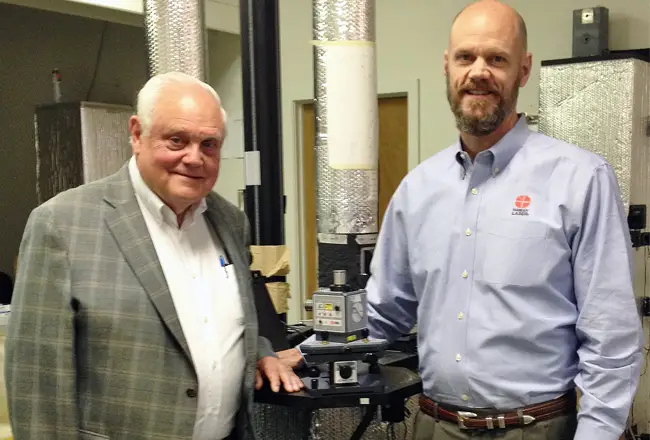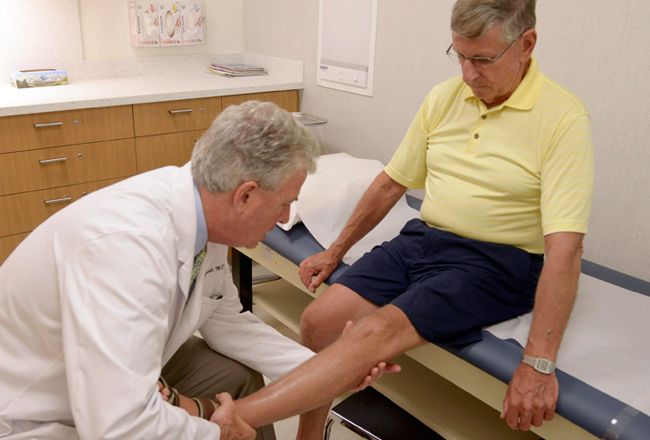
You want some entertaining stories about adventures in the laser alignment technology trade? Martin Hamar, the founder and chairman of the board of Hamar Laser Instruments Inc., which turns 50 this year in Danbury, has plenty of them.
There”™s the one about how his first day in marketing at Shelton-based biotech firm PerkinElmer began: “Hey you! You”™re selling lasers!”
“”˜Okay, what”™s a laser”™?” was Hamar”™s reply.
Or the one about starting Hamar Laser in his Wilton home: “There was a bedroom upstairs with an alcove that was meant to be a bathroom and that became my worldwide corporate headquarters.”
Or the one about baking circuit cards in his home oven to “cure” them and improve reliability: “I”™d actually baked a rocket, which was similar to a Roman candle, in there back in my days at Cornell,” he recalled. “It used zinc dust and sulfur as a propellant, and if that had gone wrong”¦”
“Then I wouldn”™t be here,” quipped his son, Hamar Laser Instruments President Rod Hamar.
The senior Hamar”™s avuncularity belies his engineering expertise. At PerkinElmer in the 1960s, he helped market the world’s first laser alignment system, designed by Spectra Physics, and as head of his own company, he has been granted 28 patents and has overseen the development of a number of firsts in the industry. Those range from a turbine laser alignment system, precision laser plane technology and automatically rotating laser plane in the ”˜70s to the trademarked Triple Scan Laser Alignment System in 1992.
The latter proved to be a game-changer. The company”™s next-generation L-743 and L-733 Triple Scan systems are the only lasers in the world to offer three automatically rotating laser planes accurate enough for today”™s ever-increasing tolerances, measuring surface flatness, squareness and straightness as well as providing the means for fixing alignment problems in a fraction of the time needed with conventional methods.
Without proper alignment ”” which used to be done with manual tools, often resulting in what Hamar called a “yeah, that looks right” solution ”” increased vibration and loads on machine tools for which they have not been designed can result. “You don”™t want that,” Rod Hamar said.
The company serves two markets: shaft and geometry. The former refers primarily to alignment of a motor to a shaft. A large electric motor connected by a shaft and coupling to a water pump in an industrial setting would be a typical application.
Hamar recently created the Stealth Alignment brand with its own website to market these shaft alignment products more effectively to customers in that market, which represents a relatively small percentage of Hamar Laser”™s output and revenue.
Geometry or geo alignment refers to alignment along multiple axes, such as with a large and complex automated machine tool that produces parts for automobiles or airplanes. To machine or “cut” parts, the various pieces of the machine tool itself may move along three to six axes — up and down, forward and back, side to side and rotary movements. The various pieces of the machine tool must be aligned properly for it to produce parts accurately. Inaccurately produced parts may not do their job well or fail quality control checks and increase scrap rates.
The family-owned company employs about 25 people, including training and sales staff at offices in Sarasota, Florida; Tucson, Arizona; Eaton Rapids, Michigan, and Mumbai, India. Headquartered in a 12,000-square-foot building at 5 Ye Olde Road in Danbury, the firm designs, manufactures, sells and services a broad spectrum of precision laser alignment and calibration systems that are “capable of tackling virtually any alignment challenge,” according to the elder Hamar.
Its customer list runs into the thousands and includes heavy hitters in industries including aerospace – Boeing Commercial and Military, Lockheed Martin, Pratt & Whitney, Sikorsky, NASA – automotive – Chrysler, Ford, General Motors, Saturn ”” fabrication – Caterpillar, John Deere, Remington Arms – machine tool manufacturing – Flow Robotics, Trumpf Power Tools, Taiwan”™s You Jia Co. ”” and power generation ”” U.S. Army Corps of Engineers, Consolidated Edison and General Electric ”” among numerous others.
The company has survived bad times. During the 1969-70 recession, Hamar jettisoned what was then a handful of employees and worked alone in an underheated basement well off the beaten path in Wilton.
“I”™d go out and sell for three months, then come back and build the orders for the following three months, then go back out,” Hamar said. “You might well question my sanity at that point ”” but I persevered and eventually got back on track.”
Rod Hamar joined his father in the business 20 years ago, after earning an MBA in finance at Columbia University and working in investment banking and sales. When his father said he needed help in HLI”™s service division, “I thought I”™d give it a try,” he said.
At the time, service comprised “2 or 3 percent of our business,” the younger Hamar said. “I didn”™t have an engineering background like my dad does, but it never occurred to me that that would be a problem ”” and it wasn”™t.”
Hamar has since gotten out of the service business. “We”™d sell a laser to a mom and pop company, and they”™d end up competing with us,” Rod said.
Although aligning machine tools, shafts, bearings and the like can pose sometimes perplexing problems ”” temperature, pressure, the tides and even the Earth”™s shape and rotation can all play a part ”” Rod said that “ignorance is our greatest enemy.”
“You have to talk to the machine operator to get at what the problem is,” the elder Hamar added. “The person running the company usually doesn”™t know and in some cases, doesn”™t care.”
Presidential election seasons usually present a marked downturn in business at Hamar Laser Instruments, which typically does $5 million in annual revenue.
“It happens every time,” Rod Hamar said. “People get nervous and pull back on ordering, wondering what”™s going to happen. But we bounce back the following spring ”” including this year.”






















